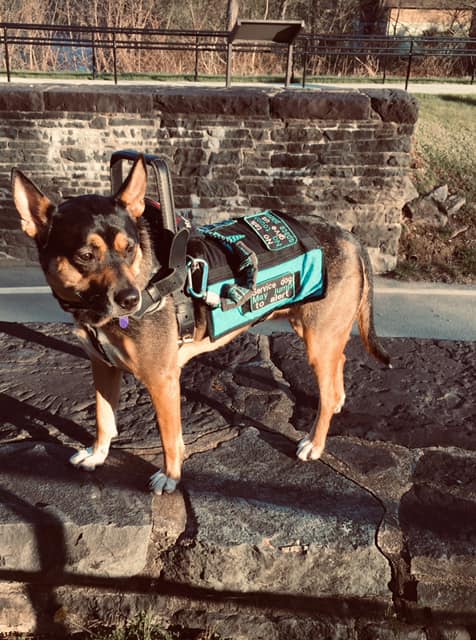Don't pet it! Especially without asking. The dog has an extremely important job to do. Even if you don't see it, chances are the dog is actively working. By petting the dog you can distract it, risking the handlers safely. Also, please don't get angry and yell when we say no. It's not your dog. You are not entitled to pet it just because “it's in public”. It doesn't mean it's aggressive. We are not only looking out for our own safety, but we want to get in and out just like everyone else. What's the longest it has taken you to go get a loaf of bread? Most likely 5 minutes on a really busy day, right? Some of us take 30 minutes because we are stopped so people can ask to pet our dog so often. It gets annoying after a while. We just want to be normal.
Don’t talk to or call it. Ignore it and pretend it isn't there. Imagine being disabled to the point you need a service dog, and when you get one people ignore you and only refer to your dog. It not only is not nice, it also can be dangerous. If you do happen to get the dog to pay attention to you instead of the handler, the dog can miss an important alert or miss a cue that they need to perform a task to help the handler. Pretend the dog isn't there just like you would with any other piece of medical equipment. You are not being rude if you ignore the dog entirely, and you actually will make the handlers day by doing so!
Don't let your kids run up to the dog. Not only is this unsafe for your child because you can't tell from looking if it is infact a service dog or not, but it's also very distracting to the team.
Don't assume just because you don't see something wrong with the handler, they are faking. You can't tell from looking at someone if they are blind, deaf, have seizures, have cardiac issues, and a ton more! Most disabilities are invisible.
Don't do anything to distract the dog. In some states you can actually be fined for distracting a service dog on purpose. If you cause the dog to miss an alert and the handler gets hurt because of it, you can be held liable.
If you have a dog or other pet, keep it away. Due to the large increase in fake service dogs, most teams have been attacked. We don't say no our dogs cant meet or ask you to stay away to be mean, its only to protect our lifeline! It puts the handler under an immense amount of stress when they see another dog approaching in fear it will attack their dog. Your dog also may innocently lunge at ours trying to play, but we can't always tell the difference until AFTER our dog has been bit if it isn't innocent. We are forced to act like it's not. It also can be very distracting to our dog when your dog is jumping on it. If you must pass a service dog with your dog, place your dog in a heel position on the opposite side of you than the service dog.
Don’t approach a service dog if you see it laying on the handlers lap. They aren't cuddling. The dog is actually doing a task called deep pressure therapy or DPT. This means the dog is using its weight to target specific pressure points to help the handler. This can help someone with PTSD ground themself, reduce the time someone is in a seizure, lower and help regulate someone's heart beat, relieve pain, and more!
It's ok to ask if they are ok but stay at a distance and try not to disturb the dog. If the handler had PTSD they may be trying to get away from people and you approaching may make it worse. If they are unconscious and the dog is in a vest, stay as far away as you can while being close enough to see if the dog has a patch to tell you what to do. Some handlers like myself are used to this and have a patch to say it is normal for us, just give us space and don't call 911 unless visibly injured. Don't try and remove the dog from the handler. You may think you are helping, but you actually will just make it worse. If the handler is injured, call 911 and check the dogs pockets. Most service dogs have a paper or card in the pocket telling you who to call in that case to get the dog and help the handler. It also may have helpful information for EMS like their diagnosis, age, weight, height etc.
8. Don't corner the handler to ask “what's wrong with you?” “why do you need a service dog?” while at first this may seem innocent...would you like it if someone cornered you and started asking about your medical history? Chances are you wouldnt. We don't like it either. We just want to blend in and be as normal as possible.
9. Don’t ask them if their dog is for sale. If you see someone walking with a dog in a service dog vest, it's their dog. They don't want to sell it. They need it to live day to day life. Don't push your money onto them. You can offer 10,000,000. They still aren't going to sell. Stop asking please.


